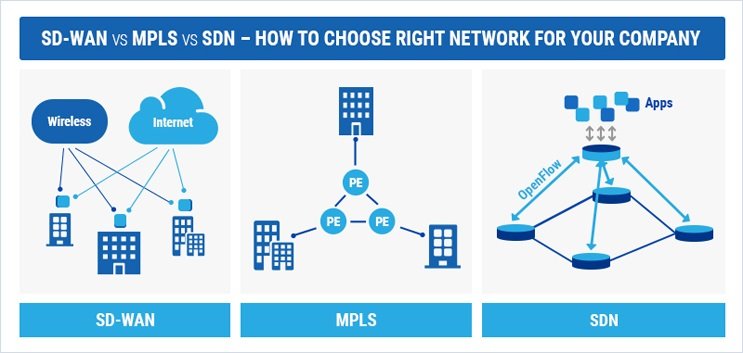Networks are essential for businesses as they support overall productivity and growth. That said, are you trying to choose between SD-WAN and MPLS for your network? Do you know the differences between these two technologies?
Understanding “SD WAN vs MPLS” can help you make an informed decision for your business. This article will explore the major differences, advantages, and disadvantages of SD-WAN and MPLS to guide your choice.
What Is SD-WAN?
Definition and Functionality
Software-Defined Wide Area Network (SD-WAN) is a virtual wide area network architecture. It allows businesses to leverage various transport services, including LTE and broadband internet services. This technology intelligently directs traffic across the network, improving application performance and user experience.
Benefits of SD-WAN
This approach offers several benefits. It provides greater flexibility and cost savings than traditional WANs. It also simplifies management with centralised control, making it easier to deploy and manage network resources.
What Is MPLS?
Definition and Functionality
Multiprotocol Label Switching (MPLS) is a technique in high-performance telecommunications networks. It directs data from one node to the next as per short path labels rather than long network addresses. Known for its reliable and secure data transfer, MPLS is a popular choice for businesses requiring consistent performance.
Benefits of MPLS
This method offers reliable and predictable performance. It provides quality of service (QoS) by prioritising critical traffic. This ensures important applications get the bandwidth they need. MPLS is also highly secure, making it suitable for businesses with sensitive data.
Key Differences
Cost Efficiency
SD-WAN is generally more cost-effective. It reduces costs by using broadband internet as part of the wide area network. In contrast, MPLS can be expensive due to dedicated circuits and premium pricing.
Flexibility and Scalability
The virtual WAN approach offers superior flexibility and scalability. It allows for easy integration of various connection types and can quickly adapt to changing network needs. The traditional method lacks this level of flexibility and can be more challenging to scale.
Performance and Reliability
MPLS is known for its high performance and reliability. It ensures consistent performance with QoS and dedicated circuits. SD-WAN improves application performance through intelligent routing. Meanwhile, it can sometimes be less predictable due to the reliance on the public internet.
Security Considerations
MPLS Security
This traditional method provides inherent security features. It uses private circuits, making it less susceptible to external threats. These networks are isolated from the public internet, providing a secure environment for data transmission.
SD-WAN Security
The newer approach also offers robust security features. It includes encryption and integrates with various security protocols. However, because it uses the public internet, additional security measures, such as firewalls and intrusion detection systems, are often necessary.
Deployment and Management
Ease of Deployment
The virtual WAN is easier to deploy compared to the traditional method. It uses software to manage the WAN, reducing the need for complex hardware setups. The older method requires more extensive infrastructure and longer deployment times.
Management Simplicity
SD-WAN offers centralised management. Network administrators can manage the entire WAN from a single interface, simplifying operations. MPLS requires more manual intervention and can be complex to manage.
Use Cases and Best Fit
Ideal Scenarios for SD-WAN
The newer technology is ideal for businesses seeking cost-effective, scalable, and flexible networking solutions. It is suitable for organisations with multiple branch locations and a need for agile network management. This option is also perfect for companies looking to optimise cloud applications and remote work environments.
Ideal Scenarios for MPLS
MPLS is best for businesses requiring high reliability and performance. It is ideal for industries with strict compliance requirements, such as finance and healthcare. This technology is also suitable for companies needing guaranteed QoS for critical applications.
Choosing between SD WAN vs MPLS depends on your business needs. SD-WAN is ideal for modern, dynamic networks, while MPLS is suitable for businesses with high demands on their network performance and data integrity. Understanding these key differences will help you make an informed decision that aligns with your organisational goals.


